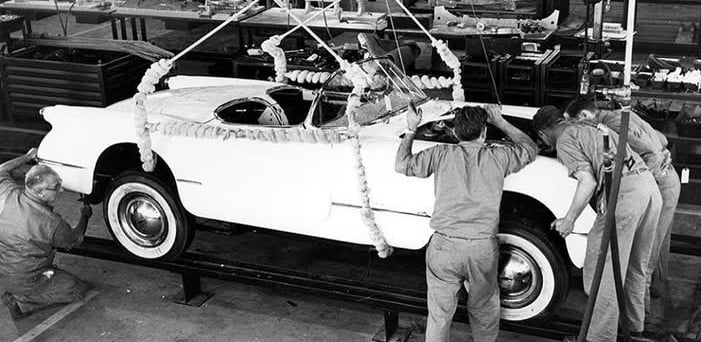The Chevrolet Corvette America's Sports car
The Chevrolet Corvette the quintessential American sports car and why it is not exactly a muscle car.
KP
8/11/20256 min read


The Chevrolet Corvette, an icon of American automotive design and performance, often finds itself placed in discussions about muscle cars. However, I believe this discussion deserves a closer examination. Does this car fit the classic definition of a muscle car? To understand this distinction, it’s important to define both the term "Muscle Car" and explore the characteristics that set this specific car apart from others.
Muscle cars are typically defined as high-performance vehicles that are primarily characterized by their powerful engines, aggressive styling, and a focus on straight-line speed. The term "Muscle car" initially originated in the United States during the 1960s and was used to define cars based on mid-size architecture, seating for at least 4, and as big of a motor that can fit between the shock towers with affordable price tags, appealing to a younger demographic looking for excitement and performance without the cost. A quintessential muscle car — think the Ford Mustang, Chevrolet Camaro, or Dodge Challenger — often featuring a V8 engine, rear-wheel drive architecture, and a muscular design.
By contrast, the Chevrolet Corvette represents a different automotive philosophy. First introduced in 1953, the Corvette was classified as a sports car. This distinction lies primarily in its design, engineering approach, and intended purpose. Thinking back to the days that this car was introduced it's main rivals were Jaguar's, MG's and Ferrari's. This vehicle was created not just for straight line speed. It was created to drive and enjoy driving. The V8 performance was actually just a next step in the evolution of the vehicle. So much so that the first corvette in 1953 did not even a use a V8! It was powered by the 150 hp Blue flame inline 6.
The Chevrolet Corvette, an icon of American automotive design and performance, often finds itself placed in discussions about muscle cars. However, a closer examination reveals that it does not fit the classic definition of a muscle car. To understand this distinction, it’s important to define both terms and explore the characteristics that set them apart.
Muscle cars are typically defined as high-performance vehicles that are primarily characterized by their powerful engines, aggressive styling, and a focus on straight-line speed. They originated in the United States during the 1960s and are usually based on mid-size cars with affordable price tags, appealing to a younger demographic looking for excitement and performance without exorbitant costs. A quintessential muscle car — think the Ford Mustang, Chevrolet Camaro, or Dodge Challenger — often featuring a V8 engine, rear-wheel drive, and a muscular design.
In contrast, the Chevrolet Corvette represents a different automotive philosophy. First introduced in 1953, the Corvette is classified as a sports car rather than a muscle car. The distinction lies primarily in its design, engineering approach, and intended purpose.
One of the primary characteristics that differentiate the Corvette is its construction. The Corvette is built as a two-seat sports car, focusing on performance, handling, and agility rather than the raw power typically associated with muscle cars. Its lightweight structure, aerodynamically optimized body, and mid-engine or front-engine layouts contribute to superior cornering abilities and overall driving dynamics, which are crucial in the sports car genre.
Muscle cars tend to focus more on sheer power and acceleration, often prioritizing straight-line performance over handling capabilities. In contrast, the Corvette is designed for agility on winding roads and racetracks, showcasing a balance of speed, handling, and driver engagement. This distinction indicates a fundamental difference in purpose between these two classes of vehicles.
Another important aspect is the engine configuration and performance tuning. While muscle cars typically feature large displacement V8 engines that deliver substantial torque and horsepower, often at the expense of fuel efficiency and refinement, the Corvette employs a more sophisticated approach. The Corvette's engine, often smaller in displacement, incorporates advanced technology such as fuel injection, variable valve timing, and lightweight materials to produce high horsepower while maintaining a balance of efficiency. This results in a car that excels in both track performance and everyday driving, resonating more with enthusiasts who value precision over brute force.
Additionally, the Corvette holds a unique place in the automotive world due to its heritage and cultural significance. It is often associated with racing and performance brands such as Chevrolet, yet it carries a distinct image that is more synonymous with a luxury sports car rather than the raw masculinity and aggressive appeal associated with traditional muscle cars. The interior of a Corvette often reflects this ethos, featuring modern technology, luxury materials, and an emphasis on driver experience that contrasts with the somewhat utilitarian interiors of classic muscle cars.
Lastly, the pricing model also sets the Corvette apart. Muscle cars have historically been designed to be affordable and accessible to a broader audience. Conversely, the Corvette, while still rooted in American muscle, has moved into a higher price bracket, often competing with European sports cars rather than traditional American muscle. This shift in market positioning highlights its evolution from a classic muscle car root to a sophisticated sports car, appealing to a different customer base looking for performance and luxury combined.
In conclusion, while the Chevrolet Corvette shares roots with the muscle car culture and embodies elements of American performance vehicles, it fundamentally diverges in purpose, design, engineering, and market segmentation. Its dual focus on high performance and refined, agile handling aligns more closely with the characteristics of a sports car than those of a traditional muscle car. Therefore, it cannot be accurately categorized within the muscle car classification and instead stands proudly in its own realm of automotive excellence.
One of the primary characteristics that differentiate the Corvette is its construction. The Corvette is built as a two-seat sports car, focusing on performance, handling, and agility rather than the raw power typically associated with muscle cars. Its lightweight structure, aerodynamically optimized body, front-engine (now midengine) layouts contribute to superior cornering abilities and overall driving dynamics, which are crucial in the sports car genre.
Muscle cars tend to focus more on sheer power and acceleration, often prioritizing straight-line performance over handling capabilities. In contrast, the Corvette is designed for agility on winding roads and racetracks, showcasing a balance of speed, handling, and driver engagement. This distinction further indicates a fundamental difference in purpose between these two classes of vehicles.
Another important aspect is the engine configuration and performance tuning. While muscle cars typically feature large displacement V8 engines that deliver substantial torque and horsepower, often at the expense of fuel efficiency and refinement, the Corvette employs a more sophisticated approach. The Corvette's engine, often smaller in displacement, incorporates advanced technology such as fuel injection, variable valve timing, and lightweight materials to produce high horsepower while maintaining a balance of efficiency. This results in a car that excels in both track performance and everyday driving, resonating more with enthusiasts who value precision over brute force.
Additionally, the Corvette holds a unique place in the automotive world due to its heritage and cultural significance. It is often associated with many racing and performance brands and has a fervent cult following, yet it carries a distinct image that is more synonymous with a luxury sports car rather than the raw masculinity and aggressive appeal associated with traditional muscle cars. The interior of a Corvette often reflects this ethos, featuring modern technology, luxury materials, and an emphasis on driver experience that contrasts with the somewhat utilitarian interiors of classic muscle cars.
Lastly, the pricing model also sets the Corvette apart. Muscle cars have historically been designed to be affordable and accessible to a broader audience. By contrast, the Corvette, while still rooted in American muscle, has moved into a higher price bracket, often competing with European sports cars rather than traditional American muscle. This shift in market positioning highlights its evolution from humble muscle car association to a sophisticated sports car, appealing to a different customer base looking for performance and luxury combined.
While the Chevrolet Corvette shares roots with the muscle car culture and embodies elements of American performance vehicles, it fundamentally breaks the mold in purpose, design, engineering, and market segmentation. Its dual focus on high performance and refined, agile handling aligns more closely with the characteristics of a sports car than those of a traditional muscle car. Therefore, it cannot be accurately categorized within the muscle car classification and instead stands proudly in its own realm of automotive excellence. This car is an icon and we dig it.
Photo Credit: Garage Dad talk




